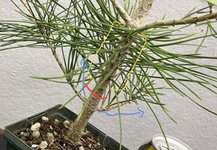skjohnson37
Sapling
Hi, all,
I'm new to the crazy, and am currently staring at my JBP (from seedling) which I believe I may have let get too big to style. In my head, I see an informal upright, but have no idea what I'm talking about. I don't even know what I don't know, though I've spent countless hours reading and watching videos in an attempt to learn before I start cutting and wiring. I live in an apartment and do not have access to outside growing. I know and understand that my conditions aren't preferable, but I'm doing my best with grow lights and letting the tree sit on my balcony getting what sun it can, though that's only a few hours per day.
In my head, I see a tree like the one in the other picture, but like I said, I have no idea what I'm talking about.
What I know is that I find bonsai relaxing and enjoyable. I know that the trees talk to me, though I have no idea what they're saying.
My plan, which I've created entirely on my own, is to repot the tree this fall into a much larger growing pot, and let it keep getting thicker, hopefully after getting some motion into the trunk. I have a few branches down low on the trunk which I believe are preferable, and would like to encourage their growth. Do I prune or pluck? Do I wire and attempt to impart motion to the trunk, or go for a formal upright?
What would be my best (not fastest, but best) paths forward in either case?
Thanks.
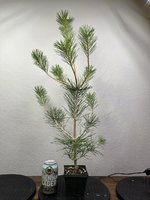
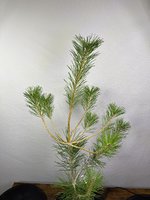
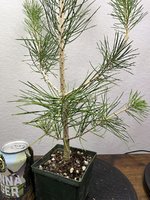
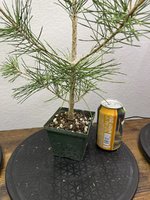
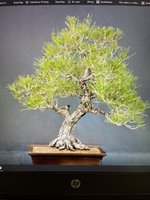
I'm new to the crazy, and am currently staring at my JBP (from seedling) which I believe I may have let get too big to style. In my head, I see an informal upright, but have no idea what I'm talking about. I don't even know what I don't know, though I've spent countless hours reading and watching videos in an attempt to learn before I start cutting and wiring. I live in an apartment and do not have access to outside growing. I know and understand that my conditions aren't preferable, but I'm doing my best with grow lights and letting the tree sit on my balcony getting what sun it can, though that's only a few hours per day.
In my head, I see a tree like the one in the other picture, but like I said, I have no idea what I'm talking about.
What I know is that I find bonsai relaxing and enjoyable. I know that the trees talk to me, though I have no idea what they're saying.
My plan, which I've created entirely on my own, is to repot the tree this fall into a much larger growing pot, and let it keep getting thicker, hopefully after getting some motion into the trunk. I have a few branches down low on the trunk which I believe are preferable, and would like to encourage their growth. Do I prune or pluck? Do I wire and attempt to impart motion to the trunk, or go for a formal upright?
What would be my best (not fastest, but best) paths forward in either case?
Thanks.






